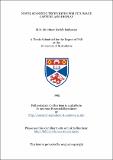Files in this item
Novel scanning techniques for CCD image capture and display
Item metadata
| dc.contributor.advisor | Killean, R. C. G. | |
| dc.contributor.author | Emberson, M.D. (Matthew David) | |
| dc.coverage.spatial | 201 p. | en_US |
| dc.date.accessioned | 2018-07-06T09:16:09Z | |
| dc.date.available | 2018-07-06T09:16:09Z | |
| dc.date.issued | 1995-07 | |
| dc.identifier.uri | https://hdl.handle.net/10023/15039 | |
| dc.description.abstract | This work details two investigations into image capture, taken from the fields of x-ray and laser research, and also details two scanning systems: a wire surface generator and a video security device. Firstly a camera system is described that can display images, digitize them and provide real time false shading. This camera is shown to have a linear intensity response and to have a maximum saturation level below the digitizing range. Some example outputs are then illustrated. The ability to irradiate CCDs with direct X-ray radiation is also investigated. A camera is developed that vertically integrates such images and is shown to give an increase in the processing speed of existing equipment and to reduce experiment times by a factor of 388. Taking this idea further, a fast one dimensional camera is developed. This camera couples laser pulses onto a CCDs via a fibre optic faceplate and a 25 mum slit. Unusual scanning techniques are used to achieve image storage within the sensor itself and a method for correcting dark current and other errors is proposed. Next a mechanism for displaying wire surface representations of intensity) images is investigated. Results obtained from real time, hidden line removing hardware are illustrated, along with improved algorithms for shaded surface generation. This is then developed into a security device protecting VDUs from radio based surveillance. This is achieved by randomizing the display order of raster lines along with a hardware solution for random sequence generation. Finally the generation of Uniformly distributed random numbers is achieved by processing readings from a digitized. Normally distributed voltage source. The effects of this processing are investigated and an analysis of the underlying theory is used to determine an optimal setting for the gain stage. | en_US |
| dc.language.iso | en | en_US |
| dc.publisher | University of St Andrews | |
| dc.subject.lcc | TK7882.S3E6 | |
| dc.subject.lcsh | Scanning systems | |
| dc.subject.lcsh | Imaging systems | |
| dc.title | Novel scanning techniques for CCD image capture and display | en_US |
| dc.type | Thesis | en_US |
| dc.type.qualificationlevel | Doctoral | en_US |
| dc.type.qualificationname | PhD Doctor of Philosophy | en_US |
| dc.publisher.institution | The University of St Andrews | en_US |
This item appears in the following Collection(s)
Items in the St Andrews Research Repository are protected by copyright, with all rights reserved, unless otherwise indicated.

